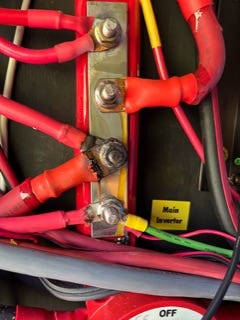Battery Bus Bar Overheating
Loose battery connections on a solar charging system can get very hot!
Everyone,
A few weeks ago one of my readers offered to send in pictures of his solar panel bus bar meltdown due to a loose terminating nut. Read on…
Hi Mike,
“I have for you here the promised photos. The nuts on the solar system bus loosened, and resistance went way up (did not measure. That conclusion was based on heat generated.)
Temp by IR thermometer when I saw this was about 280 degrees F. I was running roughly 170A at 12V at the time from solar panels. Breaker did trip, which is what had me looking for a problem. Tightened down the peak temp at peak current flow was 118 degrees F.
When installed, I had tightened the nuts on the bus down but had not checked it regularly. Notably, none of the other connections were loose except for the one on the other end of the solar cable about 6" away, which was attached to the circuit breaker. I can give you more information if you need it.
Please feel free to use it as an educational moment for loose connections. I'm now ensuring all electrical connections are tight weekly while in use.” - Bob S.
Hey Bob,
Thanks very much for the photos. I’ll cover more on battery bus bar torque values and best practices for everyone in a future article. But for now, here’s what I found on a solar panel website about bus bar installation.
Everyone please note these torque values are listed in Inch Lbs, NOT Foot Lbs.
It’s also important to use insulated tools while working on large battery systems, if possible.
A terminating nut or bolt on a bus bar or terminal that shows signs of overheating should probably be replaced and lightly lubricated for proper compression of the attached conductor(s). But more on that later.
Watch for a more in-depth article by me on battery bus bar termination practices soon.
Let’s play safe out there - Mike








We need to remember that while proper torque is important, those tables were engineered on static (non-mobile) systems. RV are subjected to major vibrations so all connections should be checked regularly. I wonder if some kind of thread locker product might be a best practice for RV's ?????
My rules for bus bars: (also applies to battery connections).
1. Make sure that the bus bars are rated for at least the amount of current you expect to ever have going through them. Use UL rated bus bars and not home made ones.
2. Never place a washer between the wire terminal and the bus bar. The wire terminal and bus bar should have a direct surface to surface contact. The flat washer should go on top of the terminal and the lock washer on top of that.
3. If you have multiple terminals connected to a single stud, have the largest (highest current) wire on the bottom and the smaller ones on top. Never stack more that 4 terminals on one stud.
4. Make sure that no insulation, dirt, or corrosion gets between the surfaces.
5. Where possible, place the biggest current source (the battery) in the middle of the bus bar and the biggest load (usually the inverter) right next to to the battery. This way the largest currents don't have to travel from one end of the bus bar to the other.
6. With stainless steel hardware it is best practice to place a tiny bit of dielectric grease on the threads to prevent galling.
7. Always use tin plated copper (marine rated) terminals in areas that will be exposed to the elements or possibility of corrosion (such as lead acid batteries).